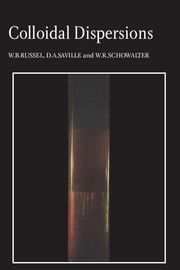Book contents
- Frontmatter
- ACKNOWLEDGEMENTS
- Contents
- Preface
- Units and physical constants
- Mathematical symbols
- 1 A Survey of Colloidal Dispersions
- 2 Hydrodynamics
- 3 Brownian Motion
- 4 Electrostatics
- 5 Dispersion forces
- 6 Forces due to soluble polymer
- 7 Electrokinetic phenomena
- 8 Electrostatic stabilization
- 9 Polymeric stabilization
- 10 Equilibrium phase behavior
- 11 Particle capture
- 12 Sedimentation
- 13 Diffusion
- 14 Rheology
- Appendix A Measured properties
- Appendix B Vector and tensor notation
- Author index
- Subject index
5 - Dispersion forces
Published online by Cambridge University Press: 05 August 2012
- Frontmatter
- ACKNOWLEDGEMENTS
- Contents
- Preface
- Units and physical constants
- Mathematical symbols
- 1 A Survey of Colloidal Dispersions
- 2 Hydrodynamics
- 3 Brownian Motion
- 4 Electrostatics
- 5 Dispersion forces
- 6 Forces due to soluble polymer
- 7 Electrokinetic phenomena
- 8 Electrostatic stabilization
- 9 Polymeric stabilization
- 10 Equilibrium phase behavior
- 11 Particle capture
- 12 Sedimentation
- 13 Diffusion
- 14 Rheology
- Appendix A Measured properties
- Appendix B Vector and tensor notation
- Author index
- Subject index
Summary
Introduction
Microscopic observations of colloidal particles in the nineteenth century revealed their tendency to form persistent aggregates through collisions induced by Brownian motion, clearly indicating an attractive interparticle force. Identification of its origin, however, awaited the quantitative descriptions of van der Waals forces between molecules developed in the 1920s (Israelachvili, 1985). This development prompted Kallman & Willstätter (1932) and Bradley (1932) to realize the summation over pairs of molecules in interacting particles would yield a long-range attraction.
Subsequently, de Boer (1936) and Hamaker (1937) performed explicit calculations of dispersion forces between colloidal particles by assuming the intermolecular forces to be strictly pairwise additive. Although approximate, this theory captures the essence of the phenomenon. The attraction arises because local fluctuations in the polarization within one particle induce, via the propagation of electromagnetic waves, a correlated response in the other. The associated free energy decreases with decreasing separation. Phase shifts introduced at large separations by the finite velocity of propagation reduce the degree of correlation, and, therefore, the magnitude of the attraction. Although the intermolecular potential decays rapidly on the molecular scale, the cumulative effect is a long-range interparticle potential that scales on the particle size.
- Type
- Chapter
- Information
- Colloidal Dispersions , pp. 129 - 161Publisher: Cambridge University PressPrint publication year: 1989
- 1
- Cited by



